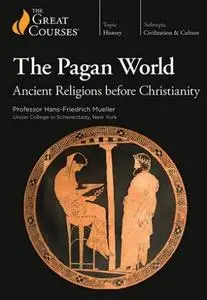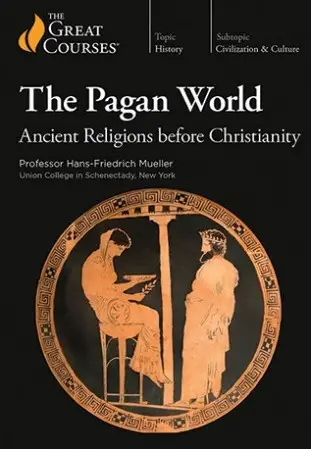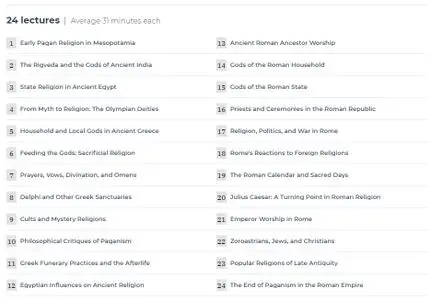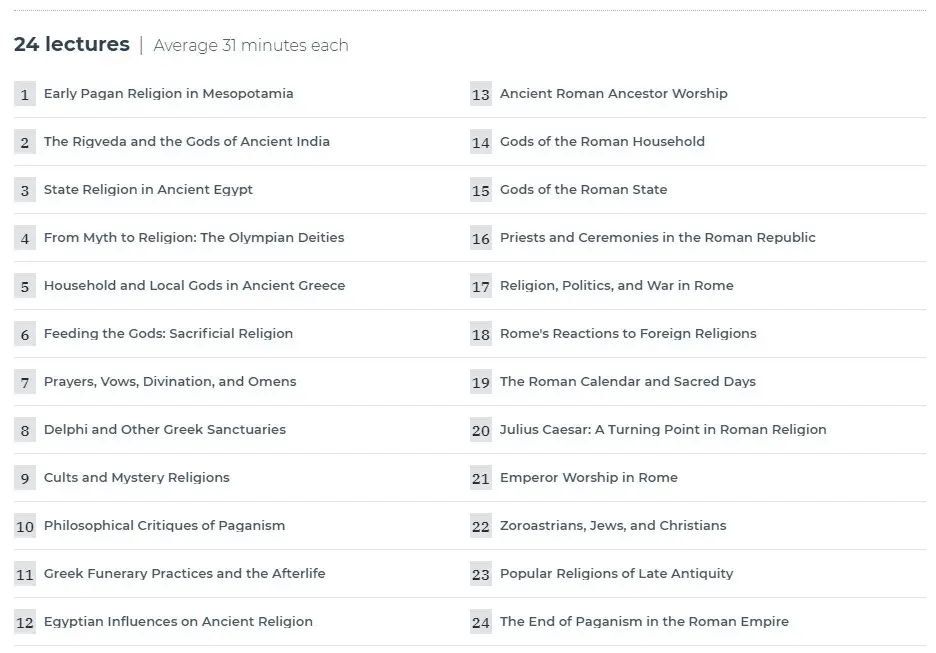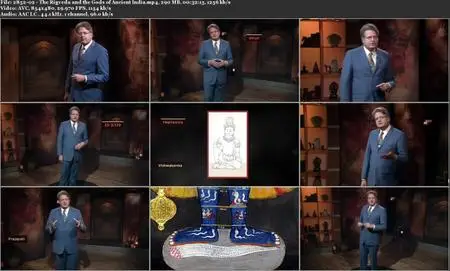TTC Video - The Pagan World: Ancient Religions Before Christianity
Course No. 2852 | .MP4, AVC, 1150 kbps, 854x480 | English, AAC, 96 kbps, 2 Ch | 24x31 mins | + PDF Guidebook | 6.72 GB
Lecturer: Hans-Friedrich Mueller, Ph.D.
Course No. 2852 | .MP4, AVC, 1150 kbps, 854x480 | English, AAC, 96 kbps, 2 Ch | 24x31 mins | + PDF Guidebook | 6.72 GB
Lecturer: Hans-Friedrich Mueller, Ph.D.
At home and on the battlefield, the leaders of ancient Rome knew their world was filled with signs from the gods, messages they needed to obey if they wanted success. Yes, they developed a well-oiled political and military machine, but they never made big decisions or went to battle without their priests and diviners.
As the famous Roman historian Livy put it: “This city was established with auspices. Who does not know that in war or peace at home or on military campaign all our affairs are conducted with auspices?” What were these auspices so crucial to the affairs of an empire? Auspices—from the Latin, meaning “one who looks at birds”—were signs from the gods revealed in the patterns of bird flight, as interpreted by the augur, a priest.
When we think about the Roman Empire, we tend to visualize massive armies conquering and plundering the peoples of the Mediterranean world. In fact, many have attributed the empire’s 1,000-year reign directly to their well-organized military might. But that’s not what the Romans thought; Roman leaders consistently ascribed the foundation of their success directly to their superior skills in religious practices.
In The Pagan World: Ancient Religions before Christianity, you will meet the fascinating, polytheistic peoples of the ancient Mediterranean and beyond, their many gods and goddesses, and their public and private worship practices, as you come to better understand the foundational role religion played in their lives. Professor Hans-Friedrich Mueller, of Union College in Schenectady, New York, makes this ancient world come alive in 24 lectures brimming with captivating stories and intriguing personalities, as well as artifacts, illustrations, and detailed quotes and descriptions from a treasure trove of original sources.
Fascinating Picture of Ancient Polytheistic Life
In the ancient Mediterranean world, religion was not separate from daily life. To the contrary, religion was daily life. These polytheists believed they had a strict contract with their deities: If they took care of their gods, their gods would take care of them. That meant following numerous rules and regulations that circumscribed almost all aspects of life both inside and outside the home. Consequently, their religion makes a wonderful lens through which to achieve a deeper understanding of their world.
Unlike modern religions that describe and even compel specific behavior between individuals, these gods weren’t as interested in policing morality. So, what about care for fellow humans? Or limits on sexual activity? Or even faith itself? Often these were not major concerns. Where the state took an interest, appropriate laws were passed and enforced. But the gods themselves traditionally judged these mortals primarily by the quantity and quality of their worship.
Those rules became the foundation of the state religion because leaders knew they could not be successful if their subjects were displeasing the gods. Consequently, they built extraordinary temples to honor their many deities, brought food and wine to them, sacrificed animals for them, and held sacred meals in the gods’ names—anything and everything to keep them happy.
Architecture, particularly remnants of temples, provide one source of our knowledge about these peoples and their practices—from the sanctuaries of Asklepios and Apollo to the Parthenon to the Caves of Mithras, and beyond. Professor Mueller, a scholar of Greek, Latin, and ancient history, is passionate about this period of history. In The Pagan World: Ancient Religions before Christianity, he discusses these extraordinary temple constructions and gives detailed descriptions from primary sources of intriguing personalities, including:
Art—Statuary, friezes, painting, mosaics, and vases throughout the Roman Empire;
Inscriptions—Pyramid texts and coffin texts found in Egypt ; and
Literature—Writings of philosophers, historians, and politicians, such as Cicero, Euripides, Homer, Lucretius, Livy, Ovid, Plato, Sophocles, and the Rigveda (a text that would become an integral part of Hinduism).
The Benefits of Divination
The many gods of this ancient world were everywhere, with spirits inhabiting every crack and crevice of life. Names of the many gods included:
Vesta, goddess of the family hearth;
Venus, goddess of sex;
Mars, god of the agricultural and military fields;
Maia, goddess of nature;
Limentinus, god of the threshold; and
Cardea, goddess of the door hinges.
Who could interpret the signs from all these deities? Even the common person could understand some. For example, did someone sneeze? Did the sacrificial animal walk willingly to the altar? If not, the gods were not interested. Did the altar burn brightly or did the flame sputter, full of smoke? Did the chickens eat greedily before the battle? Did Jupiter cause thunder and lightning in the midst of a political assembly … on a sunny day? These and other portents were viewed as a serious form of communication between humanity and the divine.
In addition, the Roman Empire had a panoply of priests, pontiffs, and augurs to interpret signs and hired Etruscan haruspices who were specially trained to “read” the entrails of sacrificed animals, particularly the livers. This was crucial; knowing how to compare what was seen inside the sacrificial animal to what was seen out in the world brought mortals and their gods into communion.
But the leadership didn’t always agree on the interpretation of signs. And at this intersection of religion and politics, there were definite benefits of divination. The difficulty of interpreting portents and signs provided a forum for discussion and debate. Those conversations fostered creative approaches to a range of possible solutions. Rather than divide society, religious debate helped move people toward consensus.
Acceptance of Other Religions
It may feel like the modern, technology-driven world of today invented globalism. But the ancient peoples of the Near East, Greece, Asia Minor, and the entire Mediterranean had already created globalism as they traded with one another, spoke with each other, borrowed (and stole) ideas, and knew each other’s cultures well. And nowhere is this more apparent than in religious practices.
For example, Roman leadership took a pragmatic position toward the unfamiliar faiths they incorporated into their territory. The newly conquered were allowed to practice their former religion—as long as their worship did not clash with the state-sanctioned religion or Roman rule. Conquest also led to rich innovations within religion as Roman society incorporated new gods and practices from the religions of their conquered peoples, including:
Worship of the Greek gods (with new Latin names);
The cult of Isis, which originated in Egypt and spread throughout the empire;
The cult of Mithras, which originated in Persia and was particularly popular among the Roman soldiers; and
Manichaeism, which also originated in Persia and addressed the duality of good and evil.
Rome did not accept all religions, however; they would not tolerate practices that went directly against the law of the land. Consequently, problems were bound to arise between the authority of the state and the worshippers of Bacchus, Druids, Jews, and Christians—something history has since proved.
We know that Christianity, Judaism, and Islam still exist in the present day—but so do some ancient, polytheistic religions, at least in some forms. Not only has there been some resurgence in the interest and practice of pagan and polytheistic religions in modern times, but the Rigveda, a collection of hymns from this ancient period, eventually became one of the four sacred texts of Hinduism—one of the most populous and influential religions of the world today. Monotheism may have become predominant in much of the world, but ancient practices and beliefs live on in our culture and many others—in stories and myths as well as in practice and faith.
When we think about the Roman Empire, we tend to visualize massive armies conquering and plundering the peoples of the Mediterranean world. In fact, many have attributed the empire’s 1,000-year reign directly to their well-organized military might. But that’s not what the Romans thought; Roman leaders consistently ascribed the foundation of their success directly to their superior skills in religious practices.
In The Pagan World: Ancient Religions before Christianity, you will meet the fascinating, polytheistic peoples of the ancient Mediterranean and beyond, their many gods and goddesses, and their public and private worship practices, as you come to better understand the foundational role religion played in their lives. Professor Hans-Friedrich Mueller, of Union College in Schenectady, New York, makes this ancient world come alive in 24 lectures brimming with captivating stories and intriguing personalities, as well as artifacts, illustrations, and detailed quotes and descriptions from a treasure trove of original sources.
Fascinating Picture of Ancient Polytheistic Life
In the ancient Mediterranean world, religion was not separate from daily life. To the contrary, religion was daily life. These polytheists believed they had a strict contract with their deities: If they took care of their gods, their gods would take care of them. That meant following numerous rules and regulations that circumscribed almost all aspects of life both inside and outside the home. Consequently, their religion makes a wonderful lens through which to achieve a deeper understanding of their world.
Unlike modern religions that describe and even compel specific behavior between individuals, these gods weren’t as interested in policing morality. So, what about care for fellow humans? Or limits on sexual activity? Or even faith itself? Often these were not major concerns. Where the state took an interest, appropriate laws were passed and enforced. But the gods themselves traditionally judged these mortals primarily by the quantity and quality of their worship.
Those rules became the foundation of the state religion because leaders knew they could not be successful if their subjects were displeasing the gods. Consequently, they built extraordinary temples to honor their many deities, brought food and wine to them, sacrificed animals for them, and held sacred meals in the gods’ names—anything and everything to keep them happy.
Architecture, particularly remnants of temples, provide one source of our knowledge about these peoples and their practices—from the sanctuaries of Asklepios and Apollo to the Parthenon to the Caves of Mithras, and beyond. Professor Mueller, a scholar of Greek, Latin, and ancient history, is passionate about this period of history. In The Pagan World: Ancient Religions before Christianity, he discusses these extraordinary temple constructions and gives detailed descriptions from primary sources of intriguing personalities, including:
Art—Statuary, friezes, painting, mosaics, and vases throughout the Roman Empire;
Inscriptions—Pyramid texts and coffin texts found in Egypt ; and
Literature—Writings of philosophers, historians, and politicians, such as Cicero, Euripides, Homer, Lucretius, Livy, Ovid, Plato, Sophocles, and the Rigveda (a text that would become an integral part of Hinduism).
The Benefits of Divination
The many gods of this ancient world were everywhere, with spirits inhabiting every crack and crevice of life. Names of the many gods included:
Vesta, goddess of the family hearth;
Venus, goddess of sex;
Mars, god of the agricultural and military fields;
Maia, goddess of nature;
Limentinus, god of the threshold; and
Cardea, goddess of the door hinges.
Who could interpret the signs from all these deities? Even the common person could understand some. For example, did someone sneeze? Did the sacrificial animal walk willingly to the altar? If not, the gods were not interested. Did the altar burn brightly or did the flame sputter, full of smoke? Did the chickens eat greedily before the battle? Did Jupiter cause thunder and lightning in the midst of a political assembly … on a sunny day? These and other portents were viewed as a serious form of communication between humanity and the divine.
In addition, the Roman Empire had a panoply of priests, pontiffs, and augurs to interpret signs and hired Etruscan haruspices who were specially trained to “read” the entrails of sacrificed animals, particularly the livers. This was crucial; knowing how to compare what was seen inside the sacrificial animal to what was seen out in the world brought mortals and their gods into communion.
But the leadership didn’t always agree on the interpretation of signs. And at this intersection of religion and politics, there were definite benefits of divination. The difficulty of interpreting portents and signs provided a forum for discussion and debate. Those conversations fostered creative approaches to a range of possible solutions. Rather than divide society, religious debate helped move people toward consensus.
Acceptance of Other Religions
It may feel like the modern, technology-driven world of today invented globalism. But the ancient peoples of the Near East, Greece, Asia Minor, and the entire Mediterranean had already created globalism as they traded with one another, spoke with each other, borrowed (and stole) ideas, and knew each other’s cultures well. And nowhere is this more apparent than in religious practices.
For example, Roman leadership took a pragmatic position toward the unfamiliar faiths they incorporated into their territory. The newly conquered were allowed to practice their former religion—as long as their worship did not clash with the state-sanctioned religion or Roman rule. Conquest also led to rich innovations within religion as Roman society incorporated new gods and practices from the religions of their conquered peoples, including:
Worship of the Greek gods (with new Latin names);
The cult of Isis, which originated in Egypt and spread throughout the empire;
The cult of Mithras, which originated in Persia and was particularly popular among the Roman soldiers; and
Manichaeism, which also originated in Persia and addressed the duality of good and evil.
Rome did not accept all religions, however; they would not tolerate practices that went directly against the law of the land. Consequently, problems were bound to arise between the authority of the state and the worshippers of Bacchus, Druids, Jews, and Christians—something history has since proved.
We know that Christianity, Judaism, and Islam still exist in the present day—but so do some ancient, polytheistic religions, at least in some forms. Not only has there been some resurgence in the interest and practice of pagan and polytheistic religions in modern times, but the Rigveda, a collection of hymns from this ancient period, eventually became one of the four sacred texts of Hinduism—one of the most populous and influential religions of the world today. Monotheism may have become predominant in much of the world, but ancient practices and beliefs live on in our culture and many others—in stories and myths as well as in practice and faith.


